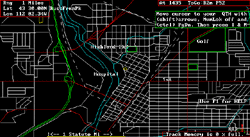|
|
|
|
Download the PDF Datasheet
PK-96 Packet TNC |
|||||||||||||||||||||||||||||||||||||||||||||||||||||||||||||||||||||||
Information Super SkywayTimewave has been researching and developing wireless digital communication devices for 19 years, providing digital operators with the most reliable and powerful equipment available. The performance of the PK-96 shows Timewave's commitment to quality. The PK-96 is a plug-in and go 9600/1200 bps TNC loaded with exciting features. Timewave engineered the PK-96 to allow people to easily step up to 9600 bps. This was accomplished by employing proven TNC hardware, utilizing Timewave's powerful command set, and including convenient features not found in other TNCs. Versatility in Modems Data Carrier Detect (DCD) Hardware HDLC Full Featured MailDrop In addition to the speed, the PK-96 comes standard with 100K (128K RAM) of battery-backed MailDrop memory. The MailDrop controls 3rd party traffic, mail forwarding, and reverse forwarding to your local BBS. There are also commands allowing you to choose who may or may not connect to the PK-96. Gateway as a Node TheNet Compatible Software Included GPS Firmware 
Remote GPS programming features add power to your TNC. The firmware allows remote programming of GPS commands. This is very handy when the TNC is installed in a vehicle-you don't need to take the unit out to change commands. The firmware also allows remote polling, so you don't have to wait for the TNC to transmit-you can force it from a remote location. Some GPS connected receivers can even be remotely programmed via the PK-96. The firmware also allows the TNC's time and date to be set from the GPS satellite. A radio control head button can be configured to send GPS information with the touch of a finger. Two NMEA strings (the data containing location information) can be programmed into the TNC. New GPS receivers give all the information you need in one string: latitude, longitude, course, and speed. We included the second string parsing ability in case where you own an old GPS receiver which doesn't have all the information in one string. GPS configurations: 2) Hardware Single Port Mode. This is where you use the optional AEA APRS™ Adapter Cable (shown below) to connect the GPS receiver and the TNC to one serial port on the computer. The application is the same as Dual Port Mode, however a computer serial port is saved. Laptop computer users will appreciate this because most only have one port. You can take this set up mobile and see on the computer screen where you are heading and where other users are heading too! 3) APRS Dual Port Mode. This is where you connect the TNC and the GPS receiver to separate serial ports on your home computer. Running APRS software, you can receive position information from other users and actually see them on your computerized map. 4) ULTIMETER II™ Stand Alone Weather Station. ULTIMETER II is a home weather station kit available from Pete Bros. You can set up the weather station, connect it to your TNC, and transmit weather information to others in your area. Weather nets can be established with help from friends. All the position and weather information can be seen from the APRS™ maps. You can really get creative with this set up. You can use the Ultimeter II temperature gauge in your home freezer and remotely access this information to see if your freezer is on, making sure meat doesn't go bad. Imagination is the limit. |
Features
Rave Reviews
|
||||||||||||||||||||||||||||||||||||||||||||||||||||||||||||||||||||||
|
|
|
APRS is a trademark of Bob Bruninga
|
To Contact Timewave
|
|||
| US Dealers | http://www.timewave.com | 651-489-5080 |
Timewave Technology Inc.
|
| Canadian Dealers |
|
360 Larpenteur Ave. W. STE 100
|
|
| International Distributors |
|
|
St. Paul, MN 55113 USA
|
|
|
| © 2007-2023 Timewave Technology, Inc. All Rights Reserved. |
